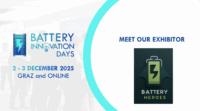Discover here the latest news for the NoVOC project
NoVOC at the Batt4EU Success Stories webinar
Projects talk with the Battery Heroes On November 13, 2025, representatives of the Battery Heroes Cluster had the opportunity to contribute to a "Projects talk" organised by BEPA and the BATT4EU partnership. NoVOC coordinator Stina Starborg from RISE presented the NoVOC project alongside our valued partners from BatWoman (Marcus Jahn, AIT Austria) and greenSPEED (Alexander Thaler, Virtual Vehicle). The BATT4EU partnership projects focusing on battery research and innovation are demonstrating impressive progress and delivering groundbreaking results across the entire battery value chain. To highlight our respective achievements and share our stories, BEPA organised this dedicated webinar. You can access the recording via the BEPA Youtube channel. The presentations can be downloaded here.
NoVOC and the Battery Heroes at the Battery Innovation Days, Graz, 1-3 Dec
The Battery Heroes will host a workshop and a booth in Graz! On December 1st the Battery Heroes, together with the COLLABAT cluster, will organise a parallel session at the Lendhafen Graz workspace to explore the sustainability and long-term impact of battery clusters beyond project duration. The workshop will feature contributions from the European Commission, BEPA, Battery 2030+ and LiPLANET, as well as other cluster initiatives (EU-INGENIOuS, TwinBATT, etc). When: December 1 Where: Graz, Austria, at Lendhafen Graz (December 1) If you are a participant of a Battery cluster of Horizon Europe projects are a representative of one of the above mentioned institutions or initiatives, please feel free to register here. As part of its stakeholder engagement commitment, the Battery Heroes will also host an exhibition stand throughout the BID event, offering a focal point for showcasing the cluster’s latest innovations, partnerships, and collaborative projects. In addition, Isabel Hanghofer, Development Engineer at VARTA and technical member of the greenSPEED project, will deliver a presentation during the session "Powering the future: Advanced processes and equipment for battery production". This presentation [...]
NoVOC sixth newsletter available
NoVOC fifth newsletter published The 6th issue of our NoVOC newsletter has recently been published on our LinkedIn channel!! 🗞️🔋 On a bi-annual basis, we share insights into our daily collaboration within our 17 partners Horizon Europe funded project. Here’s what you’ll find in this issue: 1. What we did over the last couple of months - latest updates on the project activities 2. Who we (still) collaborate with- meet the "Battery heroes 2.0" 3. Where you find us - future events and more Learn about our results, the Battery Heroes team, and our next events HERE. Follow us via our NoVOC LinkedIn channel to not miss the next issue!
NoVOC “Charge & Connect” virtual Coffee Chats on Sustainable Lithium-Ion Battery Manufacturing
Join us for the new Charge & Connect NoVOC virtual Coffee Chats Series! We’re kicking off our brand-new series of relaxed virtual coffee chats on sustainable lithium-ion battery manufacturing!! “Charge & Connect” is an open webinar series organised and hosted by the Horizon Europe project NoVOC. We bring together researchers, innovators, industry leaders, and policymakers to explore the latest breakthroughs in aqueous and dry electrode manufacturing and sustainable lithium-ion battery production through a series of relaxed virtual coffee chats. We will start on Monday, August, 18, 2025 at 2 pm CEST with the first 1-hour event, and will continue every 2 weeks for 10 weeks. Registration to each webinar opens a month in advance respectively and is done via Google Forms (links hereunder). Events that are already open for registration are marked in bold. Why attend? • Learn from leading researchers and explore cutting-edge manufacturing techniques • Connect and network with colleagues across sectors in a relaxed setting Programme Welcome and introduction 25min Key note presentation Break out sessions for networking with other battery experts Q&A session [...]
Bridging practice and policy – The Battery Heroes met the European Commission
Inspiring thoughts and policy recommendations exchanged with EC representatives On July 9, representatives of the Battery Heroes Cluster had the opportunity to engage in a focused exchange with colleagues from the European Commission, including DG RTD, DG GROW, DG CLIMA and CINEA. This open and constructive discussion was based on the practical experiences of the six Horizon Europe projects involved in the cluster and the LiPLANET network. The Commission welcomed our input with great openness, and we were encouraged by their interest in hearing directly from the field. What we shared - Key challenges across initiatives Scaling up from lab to pilot environments remains a major bottleneck due to limited resources and infrastructure. Digitalisation is hindered by a lack of data points and interoperability between systems. Project scope is often too narrow to cover the full challenge landscape outlined in the call topics. A lack of harmonised Life Cycle Assessment (LCA) methodologies across projects impedes comparability and regulatory alignment. Machinery development frequently stalls after the design phase due to insufficient support for industrial deployment. The Horizon Results Booster was [...]
The NoVOC team at the LiPlanet workshop “Quality & Sustainability in Battery R&D Pilot Lines”
A successful exchange of expertise: LiPLANET workshop on a seal of approval for European pilot lines On May 26, 2025, the LiPLANET network, in collaboration with the Battery Heroes projects, hosted an interactive workshop in Graz, Austria focused on quality and sustainability in battery R&D pilot lines. The event took place at the premises of Virtual Vehicle Research GmbH and brought together stakeholders from research and industry for an open dialogue on raising standards in pilot-scale battery manufacturing. A Seal of Approval to foster trust in European Battery Innovation The core of the workshop was the initiative to develop a Seal of Approval — a dedicated label for R&D pilot lines that demonstrate excellence in quality assurance and sustainability performance. The goal: to help industry partners identify reliable pilot lines and accelerate the commercialisation of safe, sustainable battery technologies. This mission directly resonates with NoVOC’s ambition to demonstrate VOC-free lithium-ion battery cell manufacturing, both via aqueous and dry electrode production processes, at pilot scale across Europe. Key workshop takeaways for NoVOC and beyond During the 2.5-hour workshop, participants: Explored [...]
NoVOC sparks public dialogue on Battery Sustainability at Pint of Science Festival in Stockholm
Science on tap: NoVOC experts bring Battery Research to the people On a spring evening in Stockholm, science stepped out of the lab and into the pub - as part of the Pint of Science Festival, a European outreach initiative that brings cutting-edge research to the general public in relaxed and informal settings. This year’s Stockholm edition featured two experts from the NoVOC project, sharing perspectives on the environmental and technological challenges of battery production in the era of electrification. The festival, celebrated simultaneously in over 25 countries, aims to make science accessible, personal, and engaging. As electrification and sustainability dominate both policy and public discourse, it was a fitting moment for NoVOC researchers Emanuel Bengtsson and Guiomar Hernández to join the conversation — and bring their expertise to the table (and barstool). Life Cycle Assessment (LCA) and Batteries – Can they help us reduce our Environmental Impact? Representing RISE Research Institutes of Sweden, NoVOC researcher Emanuel Bengtsson challenged the audience to think beyond the “green image” of batteries. While electric vehicles and mobile devices are often considered clean [...]
Ask the NoVOC expert #6
NoVOC "Ask the expert" series with Lucia Bombardi from Talga Which materials are inside a lithium-ion battery, and what do they do? Lithium-ion batteries might look simple on the outside, but inside, they’re made up of carefully chosen materials that each play an important role. The two key parts are the anode (negative side) and the cathode (positive side), which store and release energy when the battery charges and discharges. The anode is often made from materials like graphite or advanced composites like silicon-carbon, which can hold lots of lithium ions to boost battery performance. The cathode typically contains materials like nickel, manganese, and cobalt (NMC811), which help release lithium ions when the battery is in use, providing the power needed to run devices or electric vehicles. Between these layers is a separator (to prevent short circuits) and an electrolyte (to help lithium ions move back and forth). In the NoVOC project, we’re working to make these materials even more effective and sustainable by eliminating harmful chemicals from the battery manufacturing process. At Talga, we develop innovative anode [...]
NoVOC fifth newsletter available
NoVOC fifth newsletter published The 5th issue of our NoVOC newsletter has recently been published on our LinkedIn channel!! 🗞️🔋 On a bi-annual basis, we share insights into our daily collaboration within our 17 partners Horizon Europe funded project. Here’s what you’ll find in this issue: 1. What we did over the last couple of months - latest updates on the project activities 2. Who we (still) collaborate with- meet the "Battery heroes 2.0" 3. Where you find us - future events and more Learn about our results, the Battery Heroes team, and our next events HERE. Follow us via our NoVOC LinkedIn channel to not miss the next issue!
NEXT EVENTS
Meet the NoVOC partners at the following events:
2025
- 26-28 March, Battery Days, Graz Austria
- 2-3 December, Battery Innovation Days, Graz, Austria











